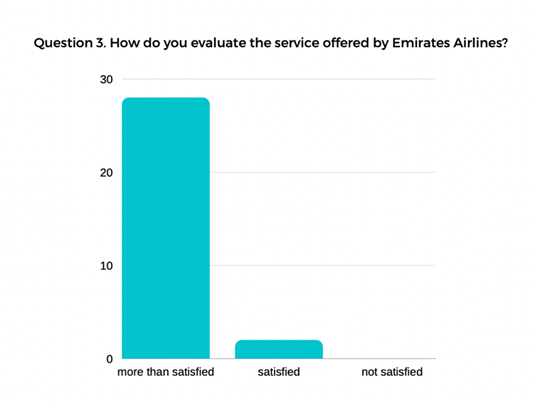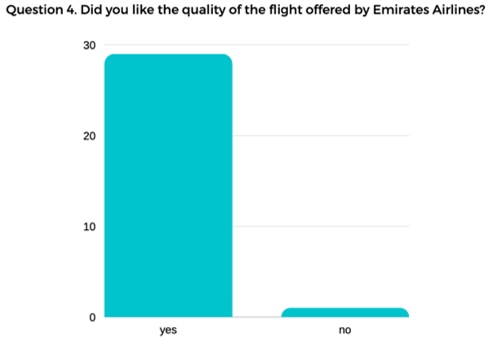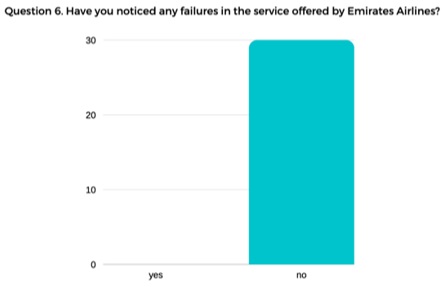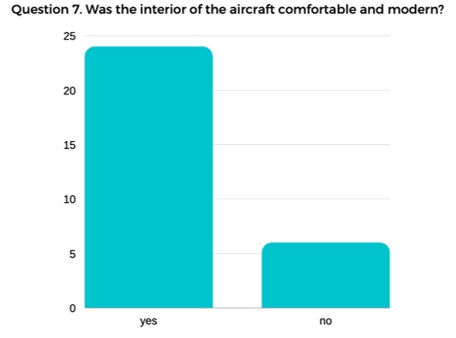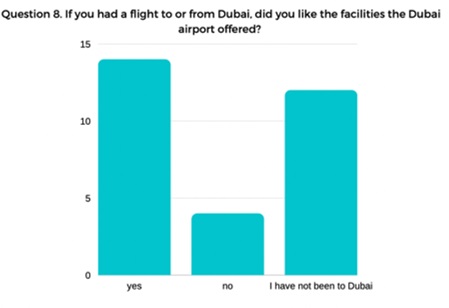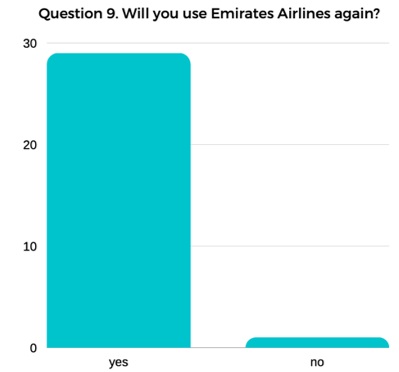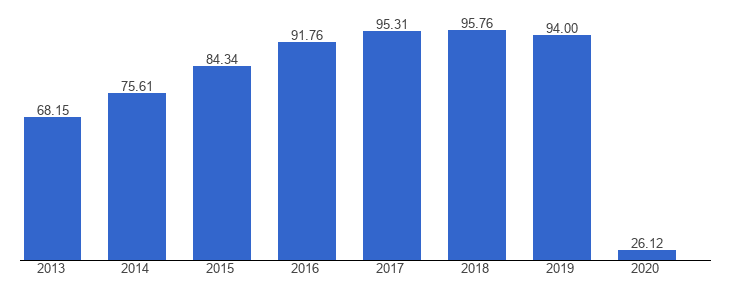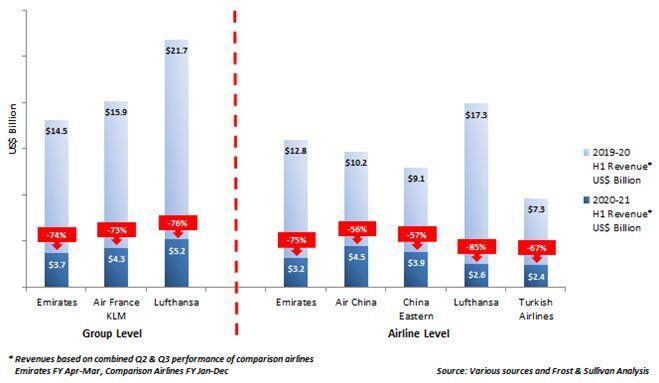Abstract
Nowadays, it is impossible to imagine the world without the airline industry because of its fast services and significant benefits, which offers to many other industries and societies. Airlines, such as Emirates Airlines, regularly alter their strategies, leading to crucial decisions like depending on the ability to increase sales or low fuel prices for long-distance travel. The airline sector is one of the most significant industries today since it helps many other industries and businesses throughout the world achieve their goals of internationalization and globalization. The performance and profitability of Emirates Airlines are utilized as a standard, and secondary research is employed to determine quality. According to the research, the company’s performance improvement and communication initiatives have helped the airline develop a positive organizational culture that has increased productivity and improved product management. A successful outcome was greatly influenced by a talented workforce and outstanding leadership. Favorable managerial and company outcomes were largely determined by cost leadership techniques. Since airlines in the area are not frequently studied, research on the marketing strategy of Emirates Airlines offers a more thorough look at business practices that promote strong growth and profitability.
Introduction
Currently, the global aviation community is actively solving the problems with which it crosses the threshold of the new millennium. These problems are associated with an increase in the absolute number of aviation accidents, congestion in air transport, an increase in the need for aviation telecommunications, and a significant increase in the operating costs of airlines. Therefore, considering rapid technology development, innovation is a crucial component of an efficient business model for competing airlines (Heiets, Spivakovskyy, and Spivakovska, 2019). In this case, the Middle East is known for its innovative air industry as the aviation sector in the United Arab Emirates has consistently made a significant contribution to the expansion and prosperity of the world economy. Hence, this paper discusses the business model of Emirates Airlines to indicate important aspects of its marketing strategies.
One of the biggest international airlines in the Middle East, Emirates Airlines, is ranked top among all airline companies worldwide. Entirely owned by the Dubai government, it serves 3600 flights per week (Kamarudeen and Sundarakani, 2019). Due to the methodical development of its marketing strategy, Emirates Airlines holds one of the top positions in the world market.
It can be stated that the regional economic climate in the Middle East is generally favorable for Emirates Airlines. The government’s dedication to enhancing transportation infrastructure, which has been defined by the construction of modern and new airports to satisfy consumer demand, is the most notable economic development that the airlines benefit from. Because the success of the region’s local airlines depends on having current technologies supported by the newest technology, for example, Abu Dhabi and Dubai plan to channel investment in the construction of airports in the region (Alshubaily, 2017). Airport improvement impulses are intended to increase tourism, strengthen the economy, and reduce reliance on the oil sector. The airline does, however, confront additional financial difficulties that cannot be resolved by expanding airport facilities. The global economy is particularly plagued by problems like currency fluctuations and financial crises that undoubtedly have an impact on the profitability of international corporations like Emirate Airlines.
The prominent forces that affect the social environment are the rise in world population, the need for speed, and globalization. First, a prospective increase in the number of travelers using air travel is implied by the expanding population. For instance, the population of the United Arab Emirates increased from 3.754 million in 2002 to over 9.346 million now, a statistic that has been linked to a 14 percent growth in the number of passengers using air travel (Alshubaily, 2017). Moreover, society places a high value on time and favors using airplanes over other forms of transportation, including roads, trains, and ships. In this sense, a social desire like this encourages operating airlines like Emirates to focus on expansion. It is especially well suited for long-distance transportation of people and cargo, especially those that are time-sensitive (Alshubaily, 2017). Finally, globalization has been characterized by the ongoing contact between nations and areas worldwide. One of the trustworthy modes of transportation for overcoming the boundaries of distance degradation is air travel. However, consumers now expect high-quality services that are ensured by offering them trustworthy, comfortable, convenient, secure, and safe services. It is interesting to note that Emirate Airlines has done well in providing superior services that emphasize these factors.
Emirate Airlines is conducting business in a society that is concerned about the environment, just like all other companies in the modern world. Everyone in society is expected to take reasonable precautions to safeguard and conserve the environment, including individuals, groups, and commercial companies. This awareness has been sparked by worries that, without environmental protection, society will not be able to meet its sustainability objectives (Alshubaily, 2017). Since widespread pollution and poor environmental management have led to negative repercussions, including sickness and global warming, the importance of the environment to sustainable development is undeniable. Like other commercial enterprises, airlines are anticipated to promote environmental sustainability by adopting actions that cause the least amount of environmental impact. By sustaining several forms of corporate social responsibility aimed at environmental protection and conservation, such as utilizing aircraft with low air emissions and noise, Emirates Airlines has done rather well. In addition, the airline supports environmental protection measures through charity endeavors like funding, research, and technologies that promote environmental sustainability (Alshubaily, 2017). This action has been essential in helping it gain a competitive edge through self-regulation and avoiding fines for breaking environmental conservation regulations.
Efficiency, safety, sustainability, and environmental preservation are the organization’s primary aims, and they can only be achieved through innovation and technology. The business realizes that there is fierce competition on the market and that winning is primarily a battle of technologies and inventions. In light of this, the organization’s operation management is unduly dependent on technologies. The organization uses technology tools like corporate resource planning systems as examples. In addition to utilizing cutting-edge technology in operation management, it is also a leader in integrating environmentally friendly technologies into various business operations, such as human resource and security management (Alshubaily, 2017). Numerous procedures are being automated, which is said to have cut costs and improved the effectiveness of service delivery. The corporation is also putting a lot of effort into training and development, which is believed to be vital in helping it keep up with technology advancements while also cultivating technological and innovative capacity.
A proper and reliable business model is needed for the company’s marketing assessment to be effective and perform quality service. Emirates Airlines has continually grown and is regarded as one of the airlines with the fastest global growth rates, offering services that meet the highest standards (Sadik, 2018). World experience shows that the most effective way to ensure the airport’s competitiveness in the market is a marketing approach that provides for the establishment of mutually beneficial partnerships between all participants in the transportation process. Accordingly, airport marketing should act as a management tool that allows for individualization and diversify both the airport business model and the parameters of its products in close cooperation with its main customers. The most important aspects of its marketing mix strategy are represented by 4Ps: product, price, promotion, and place.
All elements pertaining to the company’s core services or goods distribution are included in the product part of the marketing model. For instance, it consists of the qualitative aspects of the organization and services offered by the flights, the condition of the airports, and the aircraft themselves. According to Bhasin (2019), Emirates Airlines offers reliable and high-quality services, which have enabled it to expand quickly and generate a lot of money. Therefore, the company has maintained a professional and individualized approach to its clients to provide high-quality services. Moreover, the corporation may carry out a variety of transportation jobs and grow in the market because various types of airplanes are readily available.
Customers praise Emirates Airlines for the highly creative and convenient nature of its flights. In other words, the customers are satisfied with convenient flight arrangements, comfortable services like check-in and registration, baggage transportation, and the interior of the aircraft (Sadik, 2018). A highly motivated workforce is principally responsible for this outcome, which is made possible by a flexible personnel policy and a system of incentives and rewards. As a result, the product element of the marketing mix strategy is a major factor in the company’s reputation as one of the highest-quality and most innovative in the aviation sector.
As Dubai serves as a connecting point between the east and west, Emirates Airlines has been able to offer its clients direct flights to numerous places at affordable prices by using the shortest routes. Hence, price is another important element of a company’s marketing strategy. The organization arranges both first-class and luxurious premium flights as well as more reasonably priced flights for travelers in business and economy class (Bhasin, 2019). Because fuel prices are lower in the Middle East, Emirates Airlines sets fair and reasonable tariffs (Alshubaily, 2017). They have a significant competitive advantage over their rivals on several routes thanks to their low-cost pricing strategy, and the high passenger volume also aids in earning income. Emirates has also embraced the dynamic pricing model (Bhasin, 2019). Achieving the best price for each ticket this aids in managing the number of seats on each airplane. As a result, the cost of the seats is adjustable. This explains why clients from various social categories find the company to be appealing.
Emirates Airlines, being considered the top airline in UAE, stays up to date with contemporary marketing techniques. The business actively uses social media platforms for advertising and promoting its services. It carries out active client involvement due to contextual advertising on the Internet. In this case, promotion plays an essential role in the company’s business model. The company has used both conventional and cutting-edge marketing techniques to appeal to various customer demographics (Bhasin, 2019). Besides, Emirates Airlines provide unique reductions on airfare during off-peak travel times, which attracts more customers. As a result, Emirates Airlines’ advertising and promoting strategy has a wide potential to draw more clients. It should also be highlighted that the company’s marketing promotion strategy includes a client-centered conceptual component. Given that the business has operations worldwide, its international status is congruent with customers’ desire to travel. In relation to high-quality services and reasonable pricing, appealing to these principles is effective.
The purpose of introducing these marketing tools is to increase the loyalty of all categories of customers in relation to the company. The use of the above features of the marketing complex in the management of the airline as a business system is an important organizational and economic tool for the practical management of the competitiveness of the company and the identification of new business development opportunities. The systematized structure of the marketing complex and the airport’s clients makes it possible to ensure its optimal strategic positioning, as well as the achievement of sustainable competitive advantages in the conditions of the modern air transport market.
As was already mentioned, Dubai serves as a connection between east and west, which is highly beneficial for the company. Being based in Dubai, Emirates Airlines can therefore offer a global network of air flights on all inhabited continents, strengthening its marketing position. In this instance, the place is another important point to be mentioned in the marketing strategy of the company.
It is very important for airlines to retain customers, increase their loyalty and promote positive word of mouth. The airline’s marketing staff reads the obvious needs and true needs of the customer. Airlines can do this by providing them with the best experience of flying with them as customers mostly rely on their own experience with the airline. If an airline successfully satisfies the needs of its customers, then it makes a prominent name and money for itself. In business circles, airlines seek to gain the trust of loyal customers by rewarding them for doing business with the company consistently. Loyalty marketing motivates customers to stay loyal to a business by implementing loyalty programs (Wafik, Abou-Shouk, and Hewedi, 2017). For example, customers are provided with an electronic account with an airline where the airline can deposit frequent flyer miles that can be redeemed for their next trip.
Like other thriving industries, the airline industry faces a variety of difficulties that necessitate the use of smart management techniques. Using the top-tier airlines as benchmarks is one strategy for increasing competitiveness. In this case, Emirates Airline is one of the best-performing enterprises. This essay’s goal is to examine the critical success criteria for new and failing airlines, with a particular focus on Emirates Airlines’ strategy in relation to its rivals. The paper outlines the company’s marketing tactics in relation to its execution of associated projects, coverage of various social consumer segments, and collaboration with distributors of airline tickets.
Review of Literature
Although the global economic environment’s legislative changes have enabled an increase in aircraft capacity, profitability is still a difficult problem for airlines everywhere. Maung, Douglas and Tan (2022) studied the drivers of profitable airline growth. The paper used the dynamic system generalized technique of the moments model for this relationship. It investigated if the airline business model has an effect on the tension between growth and profits. The study used primary sources such as airline annual reports and presentations for data collection. The regression analysis was conducted as a data analysis tool. The paper concluded that whereas low-cost carriers can concurrently pursue growth-oriented strategies while increasing profitability, full-service network carriers are forced to choose between operating profits and business expansion.
Nurittamont (2019) examined how the quality of an e-service affected passengers’ intentions to remain loyal to the airline. The study conducted a questionnaire as a research method and gathered data from 295 passengers. Simple and multiple regression data analysis tools were used to test the factors influencing the respondents’ loyalty. The paper’s main finding was that e-service quality had a favorable impact on the desire to remain loyal. In addition, the author concluded that e-service is a crucial component in fostering customer loyalty and trust in low-cost airlines.
Saed, Upadhya, and Saleh (2020) studied Emirates Airlines’ marketing initiatives and how they affect Dubai’s image as a tourist destination. The study investigated an exploratory research approach by conducting a questionnaire. A total of 370 questionnaires were taken from randomly selected travelers and residents of the Emirate of Dubai from December through February 2016-2017. In addition, the study conducted a pilot survey of 50 respondents to assess the efficiency of the conceptual model, and the results were used to improve the questionnaire. Descriptive statistics were used for data analysis, which allowed the researchers to test the hypotheses.
The main findings were that if marketing is more of a push technique, branding is a strategy in that the perception made by branding occupies a long position in the buyer’s mind compared to marketing. The research shows that there is a conceptual difference between marketing and branding of destinations. The study’s findings are significant and can offer helpful advice for destination marketing and management, particularly in the case of Dubai as a popular tourist destination and its affiliation with Emirates Airlines as the designated brand ambassador.
Ceil (2019) discussed how Emirates Airlines had successfully increased its online presence to generate customer engagement through social media. As the company had used the marketing communication mix strategy to reach out to its audience and customers, the development of the Emirates brand was successful. The author stated that to engage with customers, Emirates Airlines has used a variety of online platforms, including social networking sites, content communities, blogs, and collaborative initiatives. The paper used the observational research method as it studies secondary sources’ data and statistics. The author used diagrams as a data analysis tool to collect data. The paper’s main finding is that social media has significantly helped Emirates Airlines’ promotional component of its marketing mix grow. The company has greatly benefited from the marketing communication mix of social media use in developing a brand image that is instantly recognizable and memorable.
Many airline companies exhibit the potential to produce higher profit margins despite bringing in less money, making them appealing investment prospects in a market prone to erratic and frequently trading. In this case, Redpath, O’Connell and Warnock-Smith (2017) selected two of the most diverse airline companies, Lufthansa Group and Emirates Airline, for strategic and financial assessment of their marketing strategies and impact of diversification. Interviews were conducted as a qualitative research method with several experts from both inside and outside the two chosen companies. The results were used to add more context to the financial and strategic numerical data on the two airline companies and provide evidence in support of the key ideas covered by the paper. The Strategic Scoring Method and comparative analysis were used in this research. The main finding of the paper is that diversification may not always present the most financially advantageous alternative.
Wafik, Abou-Shouk and Hewedi (2017) studied how the quality of service during the passenger journey cycle affects customers’ satisfaction and loyalty. The authors state that Emirates Airlines had a strong focus on great service and quality. The study used a questionnaire as a quantitative research method, targeting those who traveled on Emirates Airlines and EgyptAir. It collected a total of 150 forms from Emirates Airlines passengers and 180 forms from EgyptAir customers. A T-test and descriptive statistics were used to analyze the collected data. The paper revealed that travel cycle services have a substantial impact on passengers’ satisfaction while highlighting the services that customers are dissatisfied with. It concluded that despite the fact that airline services are customer-focused, airlines must always evaluate and enhance their offerings in order to grow their base of devoted patrons.
Alshurideh, Alsharari and Al Kurdi (2019) examined the connection between customer relationship management and supply chain integration in the logistics of Emirates Airlines. The paper used interviews, observations, and historical sources to collect data. The data analysis went on at the same time as the data collection process. The main finding of the paper is that for Emirates Airlines it is crucial to be able to promote operating leverage, entrepreneurial ideas, and creativity. The paper concluded that the airline sector should make strategic efforts to lower logistics costs and better meet consumer demands to be more competitive in the supply chain core of business.
Qaiser and Sultan (2019) studied how Emirates Airlines’ capital structure affected its financial performance. The quantitative research method was conducted in the paper. Moreover, the study was based on secondary sources’ data over the period from 1990 to 2015. As the data was time series, data analysis tools such as descriptive, correlation, and regression analysis were used. In particular, the tools helped to determine how much the variation in the independent variable affected the value of the dependent variable. The study findings indicated that debt to asset had no discernible impact on business performance, but debt to equity had a significant influence on Emirates Airlines’ business success.
Kamarudeen and Sundarakani (2019) examined the justification for the organization’s business and supply chain strategies by using a variety of techniques and suggested a plan for recovering from the most recent financial crisis. The business and supply chain strategies of Emirates Airlines were investigated using a case study technique, with the research highlighting both Emirates Airlines’ unique capabilities and the supply chain risks that are common to airline companies. In order to compare the Hub performance of the Airlines in this study, the authors used the Weighted Connectivity Ratio and Average Routing Factors approach. The research concluded that business and supply chain managers need to maximize the organization’s internal resources and capabilities, which can be crucial in forging a distinctive competitive advantage and boosting profit margins.
Abdul-Kadir, Sadat and Sadick (2020) studied the airline industry’s worldwide business strategies. The paper found firm-specific advantages through an investigation of four major airlines, including Ryanair, Emirates Airline, NetJets, and Thomas Cook Group. The research used a qualitative research method, using case studies of four airline companies. The paper concluded that an airline needs to have a defined plan in order to succeed in the competitive air industry.
Stanojevic (2020) examined the corporate social responsibility business model in three airline companies, including Emirates Airline, Jumeirah Group, and Rotana Group. The author stated that the corporate social responsibility model enables any corporation to be socially accountable to its stakeholders and the environment. The paper was based on the secondary qualitative data collection method. The main finding is that all three airline companies were committed to acknowledging and setting an example by upholding the Sustainable Development Goals. Moreover, the research illustrated how the broader hospitality industry can adapt and make an effort by collaborating with the hotel and aviation industries to create smart cities and fully sustainable communities.
Heiets, Spivakovskyy and Spivakovska (2019) studied the key components and characteristics of the operation of an inventive business model for a full-cycle operational airline company. They examined the network structure, components, variables, and business model innovation transformation process by concentrating on the aviation sector. The research was conducted for Emirates Airlines and Etihad Airways. The quantitative data collection method was used in the paper. Comparative and correlation analyses were implemented as data analysis tools. The paper concluded that the level of innovation in both airlines was influenced by the same variables, including United Arab Emirates’ position in the global competitiveness rankings.
Urban et al. (2018) studied the business models of different airlines and divided them into clusters to show their primary characteristics. The paper applied the Business Model Canvas to the airlines as an analysis tool for dividing the airlines into groups by their differences in business models. The quantitative method was conducted in this research. The authors stated that Emirates Airlines was grouped into high-quality network carriers with a high service level. The main findings of the research were that business models of airline companies have a tendency to converge.
Alanezi and Al-Zahrani (2020) focused on the strategic management of Emirates Airlines. The study also examines the numerous core areas under its purview that are essential for the effective design and application of Emirates Airlines’ strategic management. The authors used the Five Porter’s Forces Model technique as a research method. The SWOT data analysis tool was also applied to comprehend Emirates Airlines’ internal and external marketing settings. The main findings of the paper were an analysis of Emirates Airlines’ strategic management and how it developed from a position of weakness to become a significant challenge to the world’s top airlines in the aviation industry.
Alshubaily (2017) examined the relationships between the airlines that operate Middle East region, including Emirates Airlines, and compared their capabilities with their outcomes. The paper used secondary research data as a research method to identify the best practices. PESTEL Analysis, Porter’s Five Forces Analysis, and SWOT analysis were also used as data analytical tools. The main findings of the research were that the carriers frequently change their marketing tactics, which results in important choices like relying on the capacity for more sales or cheap fuel prices for distance.
Research Methodology
Quantitative research and qualitative research are the two categories under which communication research paradigms fall (Basias and Pollalis, 2018). Quantitative methods are based on digital data and are closely related to statistical analysis. Comparatively to quantitative methods, qualitative methods place more emphasis on interpretation and meaning as they look into the significance of the live streaming e-commerce mode in influencing consumer behavior. The qualitative approach might therefore highlight the salient variations between events (Basias and Pollalis, 2018). Both qualitative and quantitative methodologies, meanwhile, have some drawbacks. For instance, depending on how respondents interpreted the context of the issue and the questions, the data gathered from the quantitative approach of research may not be useful. Additionally, the quantitative approach may yield only a few results. In contrast, the findings from qualitative research are frequently inapplicable to the study’s intended audience. In order to determine whether there are any differences or novel perspectives among the pieces of literature about the topic, the study concentrates its investigation on quantitative research methodologies.
Objectives of the research
The proposed project aims to perform an analysis of Emirates to understand its current strategy and the major peculiarities of the company’s marketing approaches. Another goal is to achieve an improved vision of the company’s functioning through its analysis and understanding of its main approaches. Therefore, in line with the scant amount of prior research on this subject, an exploratory methodology is used in this study. The content and measurement items of the questionnaire were created based on a literature analysis and the study’s objectives, which support the aim of the research:
- To understand the theoretical framework by reviewing the relevant literature.
- To analyse the Emirates Airline strategy and marketing approaches by the third week of the project.
- To explore the effectiveness of Emirates Airline’s Marketing strategy.
- To recommend the strengths and weaknesses of Emirates Airline strategy.
Sampling techniques
Sampling is the process of choosing a sample from a person or from a big population for a certain type of research goal. There are two types of sampling which are probability sampling and nonprobability sampling (Bhardwaj, 2019). Each member of the population has a known probability of being chosen for the sample in the probability sampling. In other words, when a population is homogeneous, there is a chance that each person in the group will be chosen for a sample. As a result, the sample taken will be accurate enough to describe the whole group. Meanwhile, nonprobability sampling is a sort of sampling in which it is unknown what percentage of the population will be chosen for the sample (Bhardwaj, 2019). This means that contrary to probability sampling, in non-probability sampling, not every member has an equal chance of being chosen to take part in the study.
When choosing between non-probability and probability sampling, their advantages and disadvantages were taken into consideration. For instance, probability sampling is used to create an accurate sample and is bias method of conducting research. However, finding the right respondents is not easy when using probability sampling. Meanwhile, non-probability sampling is based on the subjective judgment of the researcher thus, it is not biased. Even though finding respondents is easier, the sample does not accurately represent the population. Based on the merits of each type of sampling, this paper used probability sampling as the aim of the project is to make an analysis and determine the strengths and weaknesses of Emirates’ marketing strategy. Therefore, the results of the research should be biased and accurate as possible.
In its turn, probability sampling is further divided into subtypes which are simple random sampling, stratified random sampling, systematic sampling, cluster sampling, and multistage sampling. After studying each type of probability sampling, it was decided to use systematic sampling. The main reason is that it is useful when complete data about the population is needed. Systematic sampling works by selecting a member after a fixed interval (Bhardwaj, 2019). Moreover, it is easy to create and conduct, and analyze the sample, and its risk factor is minimal.
The sample size must be estimated at the moment the study is proposed. A sample that is either too large or too small is both unethical and useless (Andrade, 2020). Meanwhile, a sample area is needed when a complete frame of reference is not available. Small sub-areas of the overall investigational area are sampled at random or in accordance with a defined process like sampling. Thus, a total of 30 online questionnaires were distributed to a randomly chosen sample of tourists and inhabitants of Dubai.
Data Collection
In the subject of research, the data collection method is crucial as it serves as a fundamental research tool. There are essentially two different categories of data: primary and secondary. In the field of behavioral sciences, observation techniques, interviews, questionnaires, and databases are the most often used primary data collection techniques. The sources of secondary data include unpublished memoirs and biographies as well as previously published books, magazines, journals, etc. The method of data collecting is chosen based on the purpose of the study and its applicability to that specific study’s design.
When conducting research, primary data is gathered either through observation or through direct engagement with respondents. Data that are new, original, and freshly obtained are referred to as primary data (Mazhar et al., 2021). Primary data can be obtained through a questionnaire, which was also conducted in this paper. In this case, a questionnaire is distributed to the relevant parties with a request that they complete it and return it. A questionnaire is made up of a number of questions that are typed on a form or set of forms in a specific order (Mazhar et al., 2021). The questionnaire is mailed to responders, who are required to read the questions, understand them, and respond in the space provided for that purpose on the actual questionnaire. The answers to the questions must be given by the participants on their own.
A questionnaire is a set of questions that are predefined and distributed to many respondents. This tool works well for gathering data from a large number of sources. Additionally, questionnaires are useful for gathering data from people who are dispersed across a large area and who are challenging to reach in person. Questionnaires should always uphold the highest standards of morality and ethics, just like all other methods of data collecting (Mazhar et al., 2021). Thus, the research’s purpose was briefly described in the questionnaire.
The questionnaire was directed to analyze the marketing strategy that impacts consumers’ behavior and passengers’ satisfaction. These factors include the components of the marketing mix strategy, which are product, price, promotion, and place. In other words, the satisfaction of the passengers with the quality of the service of Emirates Airline was tested. To make it easy to analyze collected data and make a graphical presentation of the answers, the questions needed to choose based on the respondents’ feelings on how much they agreed or disagreed with each answer on a scale from 1 to 5.
The secondary source of information was gathered from online databases. Mainly journal publications, magazines, and books were chosen as secondary source data so the information taken would be reliable.
Data Analysis and Discussion
Data analysis is the methodical use of statistical and logical techniques to specify the range of the data. There is a theory regarding this aspect of the study called explanation data analysis (EDA) (“Exploring the theories of data analysis,” 2018). It consists in the fact that information is selected for research that contains valuable information for the work. Moreover, this theoretical approach is close to confirmatory data analysis (“Exploring the theories of data analysis,” 2018). In this case, the information is analyzed and evaluated to maintain or refute the concepts derived from EDA. By removing the extra confusion that the remainder of the data’s analysis would have produced, these analytical techniques allow deducing the underlaying inference from the data. Data analysis is a continuous, iterative process where data collection and analysis are done simultaneously since data generation is a constant activity (Arora, 2022). One of the key elements of data analysis is ensuring data integrity.
This paper examines how Emirates Airline’s business and marketing strategy have developed. To analyze numerous external impacts on business and potential future trends that may affect the industry, a macro environment analysis has been found to be useful. Understanding industry rivalry and outlining impacts on the market and business development were studied with an analysis of Porter’s five forces. The company can develop a strategy to stay ahead of these influences using this approach. The focus is also on examining the internal environment. Therefore, a SWOT analysis is crucial when evaluating the company’s plans in place, important resources, and business success. This is done in an effort to aid management in determining how to best leverage organizational strengths, decrease the effects of weaknesses, maximize opportunities, and minimize the effects of threats.
Poster’s Five Forces
Poster’s Five Forces analysis was conducted to assess the market environment in which Emirates Airline operates. The environmental considerations that could limit how well airlines compete in the market include both internal and external elements (Bruijl, 2018). The framework takes into account a set of five crucial factors, including risks from competing products, new market entrants, threats from existing rivals, supplier bargaining strength, and customer bargaining power.
Threats from Existent Competitors
Competitors with operations in the same region and beyond pose a possible threat to Emirates Airline. The existence of already existent competitors has a big impact on Emirates Airline’s revenue and profitability. This forces to adopt tactics to reduce the impact of rivals. In fact, the airline has largely relied on intelligent marketing strategies and product design to dominate its rivals. For instance, the business aims to provide services that meet customers; needs for value. Moreover, to accommodate consumers from all socioeconomic backgrounds, the organization offers both executive and low-cost services. To design and adapt its products to the passengers and increase its market share, Emirates Airlines use the 4Ps of the marketing mix as it was mentioned before.
Threats from New Entrants
A highly lucrative and changing market encourages an increase in competitiveness. In 2021, tourism grew by 4 percent, according to World Tourism Organization (2022). Therefore, it is expected that new businesses will join the industry and have some market share. As a result of the increasing demand, Emirates has prospered by exploiting new regional markets for great profitability. The novelty that the new air transportation and freight industries can offer is what drives the threat of new entrants. Moreover, the competitors in the airline industry may come from all parts of the world rather than just the local market. Even if they are weak, the possibility of alliances and joint ventures with local businesses could give the new entrants a platform to upset the balance of the local market. Emirates Airlines uses the same strategies used to combat its current rivals to counter the dangers posed by prospective entrants.
Consumer Bargaining Power
There is fierce competition among local and worldwide airline companies. The power of today’ consumers to demand cheaper pricing, better service, and higher product quality could pose a danger to Emirates. Therefore, due to price reductions and increased investment in product innovation, Emirates is unlikely to experience large rates of turnover over time. Emirates Airlines must contend with strong consumer negotiating power. In other words, the customers have a power to select from a variety of airlines. Customers need high-quality services that are reliable, convenient, affordable, secure, and cost-effective, among other things. The ability of any airline to meet the various expectations of customers will therefore determine its level of success in the market. The Emirates has been making an effort to be sensitive to various client needs, and this effort is reflected in the design, delivery, and marketing of its products. In each of these procedures, the airline works to win over customers in order to win their loyalty.
Threats from Alternative Products
The majority of airlines provide goods with comparable qualities such as low cost, high quality, and modern service. Therefore, when the majority of competitors reach a point where they can offer new items globally, Emirates may face difficulties. This means a broader selection of products with lower prices but higher quality benefits consumers. Some tourists are advised to forgo flying altogether in favor of teleconferences and other types of electronic communication. Because travelers have been delaying trip plans until travel costs are more attractive, the demand for travel has also been declining. Airlines have had to reduce the cost of their goods as a result of declining demand and increasing competition. The number of passengers has increased and stabilized as a result of the significant reductions and enhanced discounting techniques. The rules have given other airlines, including Emirates Airlines, the freedom to take advantage of the market by combining their positions in other sectors.
Supplier Bargaining Power
The proportional strength that suppliers can exercise in the marketplace to affect the performance and success of businesses is referred to as the suppliers’ negotiating power. In essence, the suppliers’ ability to influence prices is always a crucial factor in guiding investment decisions. The type and distribution of raw materials, the source of energy, and labor dynamics are all factors that affect a supplier’s ability to bargain. The target environment portrays providers’ bargaining position as being weak. Emirates Airlines would undoubtedly be able to take use of this as an advantage. Airlines are being produced and sold by a variety of businesses. These are in such competition that they have reduced the cost of the aircraft for the carriers. The consulting services are also reasonably priced, which is a trend brought on by globalization, which has made it possible to use businesses from all over the world. Additionally, the labor dynamics are favorable. Compared to the rate of increase of job opportunities, the world’s population has been expanding more quickly. This tendency suggests that qualified workers will have few job options. Emirates Airlines has the ability to exercise command over the qualified staff it can hire and the labor compensation plans it can provide. The energy component could be difficult. Because of the rising demand, oil prices have assumed an upward trend. In order to prevent this from harming its success, Emirates Airlines will need to take steps. It is feasible. Indeed, Emirates Airlines has the option to improve its bargaining and negotiating power with suppliers by forming partnerships and alliances with like-minded companies.
The two leading aircraft manufacturers for international airlines are Boeing and Airbus. All airlines have placed orders with one of them for the newest aircraft. Emirates still has to worry about paying more or perhaps experiencing delivery delays despite being a significant buyer. Additionally, because the essential products are unique and the suppliers have a high level of competence, Emirates is heavily dependent on these providers.
SWOT Analysis
Porter’s five force analysis makes it possible to imagine Emirate Airlines as having a variety of advantages that drive it to maintain its dominant position in the market, which new and struggling airlines could imitate. However, the evaluations also highlight many dangers and weaknesses that struggling and fledgling airlines should be aware of. The results of the analysts’ SWOT analysis are summarized in the figure below.
Findings
Regarding the survey questionnaire, in the 30 valid samples, there are a total of 18 males and 12 females (Appendix 1). More than 88% of the samples used Emirates Airlines’ service more than 5 times (Appendix 2). 92% of the respondents highly evaluated the service offered by Emirates (Figure 1).
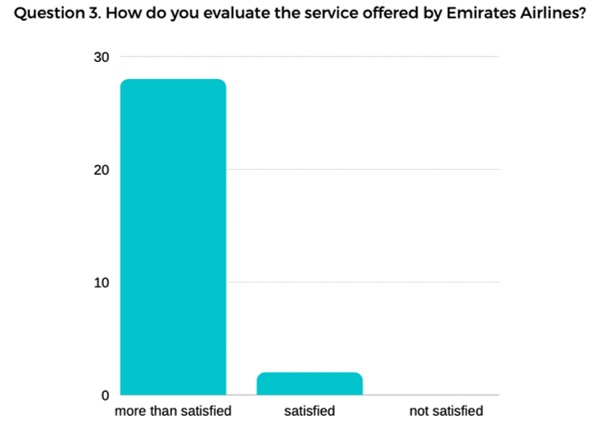
95% of the passengers liked the quality of the flight by Emirates Airlines (Figure 2).

Only 10% percent of the respondents had any difficulties during registration or check-in (Appendix 8). According to Figure 3, no one answered they had noticed any failures in the service of the company.
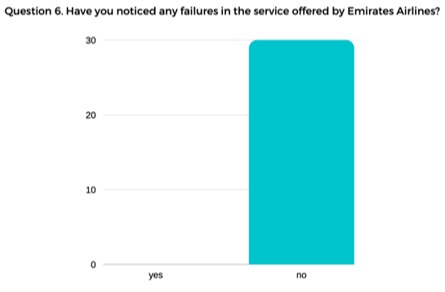
About 80% of the respondents noted that the interior of the aircraft was comfortable and modern (Appendix 4). It was pleasant to be in it and people did not experience discomfort when traveling on airline planes. 80% of those who had flown from or to Dubai also liked the facilities offered by the Dubai airport (Appendix 8). Approximately 95% of the customers will use the service of Emirates Airlines again (Figure 4). This aspect reflects the fact that the company successfully performs its functions to provide high quality work.

Based on the evaluation of the results, it can be stated that Emirates Airlines provide high-quality service, which means that the company invests enough money to increase product quality. Most of the respondents noted the high level of the airline’s service and the pleasantly and comfortably organized space of the airport. Moreover, it is worth noting that the Airlines have loyal customers who had given positive feedback on the quality and price of the services, so the company’s strategy on marketing and advertisement is working. In generall, people did not experience any difficulties during registration or check-in and did not noticed any failures in the service offered by Emirates Airlines.
Conclusions and Recommendations
According to the report, Emirate Airlines is headed in the right direction for preserving its market share and growing even more through uniqueness. The leadership team’s perseverance and dedication are the only factors that will enable progress. The conclusion that can be drawn from the analysis of Emirates Airlines’ strategy is that the airline has been very successful in realizing most of its strategic objectives and vision. The airlines’ inventive and technological capabilities have allowed them to position themselves advantageously in the market. Additionally, via its initiatives and the value it provides to its customers, Emirates has successfully positioned itself in the highly competitive environment of the aviation sector. However, the firm faces significant threats and difficulties from international rivals, rising costs, and a hierarchical network that can be overcome with the aid of various techniques.
The various business tactics that the airline employs are what differentiates it from its competitors. For instance, Emirates’ approach to resource management optimizes for operational needs. Several aspects, both internal and external, are viewed as interrelated, and that must all be taken into account in the operation management process to determine if it is successful in achieving the objectives that underlie its actions. The resource management method essentially follows the tenets of the one systems approach, which emphasizes considering things as a system of interrelated items rather than as separate pieces. In keeping with this assertion, the airline admits that efficient management of both human and non-human resources is essential to helping the business achieve its short- and long-term objectives. However, it also recognizes the paradigm shift towards humanistic approaches, which calls on businesses to view their people as their most valuable resource in order to gain a competitive advantage. The Emirate has made an effort to motivate, train, and develop its staff in order to support them in enhancing their capacity to perform effectively in order to accomplish this.
This strategy differs from those that are commonly used by fledgling airlines in that it uses multiple path techniques to reduce risk while still having a resource management process that, while it does exist, has a limited reach. In controlling risks, many pathways are rarely used, especially when managing large and complicated projects. This is due to the extensive list of tasks involved and the hard nature of this strategy. Because of this, the numerous routes strategy necessitates complex software for effective management, thereby raising the organization’s operational expenditures. In fact, it has been noticed that having several paths would call for a redesign in the event that adjustments need to be made as the project is being carried out. The results could be so bad that a company or organization might crumble. Non-critical risks having the potential to reduce an organization’s performance it has been highlighted. In addition, if non-critical risks are not managed, the organization is probably going to lose its reputation. Delays in the delivery of goods to customers, unsolved difficulties impacting organizational staff, and failures in information technology within an organization are just a few examples of prevalent non-critical challenges in enterprises.
Safety on commercial flights is of the utmost importance. Emirates, the biggest airline in the world, has the best fleet for ensuring flight safety. Since its introduction, there have been no significant air mishaps, and there have also been no fatalities or serious injuries. Even an airline’s annual profit might be lost with the loss of a single aircraft. Furthermore, the accident of just one plane has resulted in the closure of other airlines due to the detrimental effect on marketing. The fleet is run by Emirates Airlines’ most effective management in a manner that has made it a model airline in the aviation sector.
It is important that Emirates management recognizes its skills and competitive advantages and ascertains how competitive it is in the industry through an analysis of the internal and external surroundings. As a result of this research, there are repercussions that call for Emirates to adapt to environments like politics, technology, and especially the current economic slowdown. In order to maintain its position as the world leader in aviation, management is well informed of any impending problems and creates new plans in response.
In conclusion, the purpose of this essay has been to examine the critical success elements for new airlines, with an emphasis on an investigation of Emirates Airlines as a role model. It has been established that its strengths, as well as the capacity to recognize and seize market opportunities as well as address market-specific dangers, are responsible for its success. High levels of innovation, a sizable regional and global market share, active marketing and promotion strategies, an emphasis on quality and the provision of value for money, technology consciousness, environmental social responsibility, and upholding laws and regulations are among the most notable threats. Additionally, the supply chain for Emirates is thriving and supported by overall quality control, which emphasizes a number of areas, including systematic and strategic management, continuous improvement, evidence-based decision-making process, and communication. The company has been taking advantage of opportunities such as the positive political climate, the existence of new, cutting-edge airports with cutting-edge technology, the prospective social environment fuelled by the need for speed, globalization, and population growth, and the evolving technology and innovative environment. The vivid 4Ps of marketing serve as the foundation of Emirates’ marketing strategy, which is the company’s source of competitive advantage.
The company has been particularly concerned about the following concerns: expanding laws, financial crises, threats from rivals and new entrants, threats from existing products, political unrest, and terrorism. Based on the analysis, it can be concluded that Emirate Airlines is on the right path to maintaining its market share and achieving further expansion through distinctiveness. Only tenacity and commitment from the leadership team will allow for things to be accomplished. Young and struggling airlines are therefore urged to adopt Emirate Airlines’ operational strategies, concentrate on seizing the possibilities at hand, remain vigilant of potential dangers, and overcome their deficiencies by addressing them.
The airline industry is incredibly dynamic and intricate. The target market’s demographic and behavioral aspects are crucial in determining the airline’s performance. Emirates has used thorough market research methodologies to successfully address the constantly shifting customer preferences. However, since a number of rivals began offering high-end services at significantly lower prices, Emirates has been losing out on business. Retaining dependable clients is a key goal of effective marketing management. The possibility of market share acquisition is merely the second phase. The aforementioned marketing plans are suggested while taking into account different market trends. By implementing them, Emirates would defeat the incoming competition and take the lead.
Significance for Stakeholders
Different types of rules and regulations that various organizations adhere to define the operating environment in which Emirate Airlines operates. Environmental protection, tort laws, contract laws, affirmative action, and workplace health and safety are a few examples of legislation. Emirate Airlines is devoted to matching its operations with the requirements of the various jurisdictions because it recognizes the serious repercussions of breaking laws and regulations. The company’s operational management objectives are outlined and can be observed to be focused on the components like efficiency, safety, sustainability, and environmental protection.
Efficiency is the first component, and it aims to reduce crowding and delays at the facility. The second component is safety, which is concerned with preventing injury to people and property when they come into touch with the facility environment. Sustainability, which emphasizes guaranteeing the return on investment, is the third component. Environmental protection, which aims to minimize damage to the environment, is the final component. The airline also accepts that it is its job to integrate all of the area’s operation activities because the process of attaining the goals supporting the four components primarily depends on how the products and processes are developed and rendered. Thus, the research aims to deeply analyze the marketing strategy of Emirates Airlines and it can serve as a guide for different stakeholders, employees, and businesses.
Statement of Self-Reflection
I had opportunities to meet with my project mentor, and during these meetings, I was able to get practical assistance with a variety of work-related issues. First, I was mostly focused on outlining what I expected from the research. Therefore, we discussed the choice of research approach and the creation of research objectives. Then, after the introduction part was finished, I investigated research on the relevant literature and data collection methods of my research.
During the research, the validity of the data analysis techniques and their applicability to the research questions served as the basis for the methodology selection. Analytical tools, which are Foster’s five forces analysis and SWOT analysis, have been picked to be included in my research after investing more time in selecting and studying the best technique for data collection and analysis. After I finished all the work and was writing a conclusion, my mentor remarked that my work lacked scope and hypotheses. After addressing these issues, the research report was written.
It is reasonable to say that all of the research objectives in my research report have been adequately addressed in the paper by studying credible secondary data, and the study’s methodology was appropriate. I believe the research results were examined.
Bibliography
Abdul-Kadir, A., Sadat, A. and Sadick, A. A. (2020) ‘Global strategies of the airline industry: a case study of Ryanair, Emirates, NetJets, and Thomas Cook’, StudNet, 3, pp. 204-217.
Alanezi, F. and Al-Zahrani, R. (2020) Strategic management of Emirates Airlines. In: 2nd Asia Pacific information technology conference. Bali Island, 2020. New York: Association for Computing Machinery, pp. 172-177.
Alshubaily, A. (2017) ‘Exploring the key success factors for young airlines – a focus on Emirates Airlines and its regional competitors’ strategy for success’, Saudi Journal of Business and Management Studies, 2(1), pp. 30-37. Web.
Alshurideh, M., Alsharari, N. M. and Al Kurdi, B. (2019) ‘Supply chain integration and customer relationship management in the airline logistics’, Theoretical Economics Letters, 9(2).
Andrade, C. (2020) ‘Sample size and its importance in research’, Indian Journal of Psychological Medicine, 42(1), pp. 102-103.
Basias, N. and Pollalis, Y. (2018) ‘Quantitative and qualitative research in business & technology: justifying a suitable research methodology’, Review of Integrative Business and Economics Research, 7(1), pp. 91-105.
Bhardwaj, P. (2019) ‘Types of sampling in research’, Journal of the Practice of Cardiovascular Sciences, 5(3), pp. 157-163.
Bhasin, H. (2019) Marketing mix of Emirates airlines – Emirates marketing mix.
Bruijl, G. H. Th. (2018) ‘The relevance of Porter’s Five Forces in today’s innovative and changing business environment’. SSRN.
Ceil, C. (2020) ‘Social media effects on Emirates Airline’.
Exploring the theories of data analysis: EDA, CDA, and grounded theory. (2018). Idashboards.
Heiets, I., Spivakovskyy, S. and Spivakovska, T. (2019) ‘Innovative business models for full cycle operating airlines’, International Journal of Business Performance Management, 20(4), pp.356-377.
Kamarudeen, N. and Sundarakani, B. (2019) ‘Business and supply chain strategy of flying above the dessert: A case study of Emirates Airlines’, 9th International conference on operations and supply chain management, Vietnam.
Maung, Y. S. Y., Douglas, I. and Tan, D. (2022) ‘Identifying the drivers of profitable airline growth’, Transport Policy, 115, pp. 275-285.
Nurittamont, W. (2019) ‘Enhancing e-service quality of airline industry: an empirical study in customers of low cost airline’, International Journal of the Computer, the Internet and Management, 27(1), pp. 91-95.
Qaiser, A. and Sultan, A. (2019) ‘Impact of capital structure on business performance: a case of Emirates Airline’, Amazonia Investiga, 8(21), pp. 62-72.
Redpath, N., O’Connell, J. F. and Warnock-Smith, D. (2017) ‘The strategic impact of airline group diversification: The cases of Emirates and Lufthansa’, Journal of Air Transport Management, 64, pp. 121-138.
Sadik, R. M. (2018) ‘Implementation of total quality management in airline (case study Emirates Airline)’, International Journal of Advances in Computer Science and Technology, 7(5), pp. 22-25.
Saed, R. A., Upadhya, A. and Saleh, M. A. (2020) ‘Role of airline promotion activities in destination branding: case of Dubai vis-à-vis Emirates Airline’, European Research on Management and Business Economics, 26(3), pp. 121-126.
Stanojevic, S. (2020) ‘Embracing sustainability in the drive from ordinary to outstanding: case examples from Emirates, Jumeirah, and Rotana’, Worldwide Hospitality and Tourism Themes, 12(5), pp. 575-586.
Urban et al. (2018) ‘Airline categorization by applying the business model canvas and clustering algorithms’, Journal of Air Transport Management, 71, pp. 175-192.
Wafik, G. M., Abou-Shouk, M. A. and Hewedi, M. M. (2017) ‘Airline passenger travel cycle, satisfaction and loyalty: a comparison of EgyptAir and Emirates Airlines’, International Journal of Hospitality & Tourism Systems,10(1), pp. 1-12.
World Tourism Organization. (2022) Tourism grows 4% in 2021 but remains far below pre-pandemic levels.
Appendices


